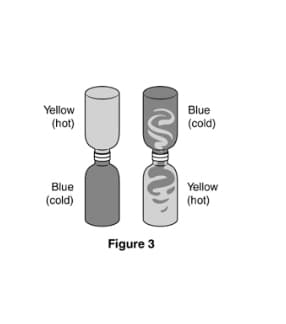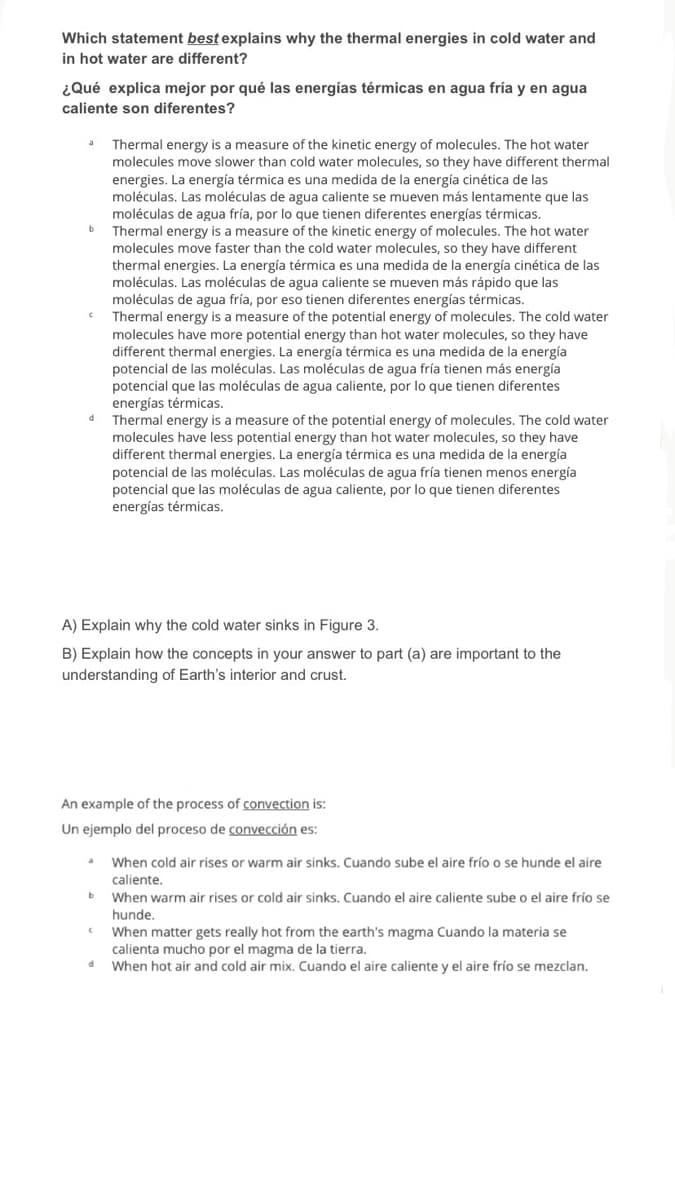Chapter9: Energy For Today
Section: Chapter Questions
Problem 1E
Related questions
Question
Need help with this pls

Transcribed Image Text:Blue
(cold)
Yellow
(hot)
Blue
(cold)
Yellow
(hot)
Figure 3

Transcribed Image Text:Which statement best explains why the thermal energies in cold water and
in hot water are different?
¿Qué explica mejor por qué las energías térmicas en agua fría y en agua
caliente son diferentes?
Thermal energy is a measure of the kinetic energy of molecules. The hot water
molecules move slower than cold water molecules, so they have different thermal
energies. La energía térmica es una medida de la energía cinética de las
moléculas. Las moléculas de agua caliente se mueven más lentamente que las
moléculas de agua fría, por lo que tienen diferentes energías térmicas.
Thermal energy is a measure of the kinetic energy of molecules. The hot water
molecules move faster than the cold water molecules, so they have different
thermal energies. La energía térmica es una medida de la energía cinética de las
moléculas. Las moléculas de agua caliente se mueven más rápido que las
moléculas de agua fría, por eso tienen diferentes energías térmicas.
Thermal energy is a measure of the potential energy of molecules. The cold water
molecules have more potential energy than hot water molecules, so they have
different thermal energies. La energía térmica es una medida de la energía
potencial de las moléculas. Las moléculas de agua fría tienen más energía
potencial que las moléculas de agua caliente, por lo que tienen diferentes
energías térmicas.
Thermal energy is a measure of the potential energy of molecules. The cold water
molecules have less potential energy than hot water molecules, so they have
different thermal energies. La energía térmica es una medida de la energía
potencial de las moléculas. Las moléculas de agua fría tienen menos energía
potencial que las moléculas de agua caliente, por lo que tienen diferentes
energías térmicas.
A) Explain why the cold water sinks in Figure 3.
B) Explain how the concepts in your answer to part (a) are important to the
understanding of Earth's interior and crust.
An example of the process of convection is:
Un ejemplo del proceso de convección es:
When cold air rises or warm air sinks. Cuando sube el aire frío o se hunde el aire
caliente.
When warm air rises or cold air sinks. Cuando el aire caliente sube o el aire frío se
b
hunde.
When matter gets really hot from the earth's magma Cuando la materia se
calienta mucho por el magma de la tierra.
When hot air and cold air mix. Cuando el aire caliente y el aire frío se mezclan.
Expert Solution
This question has been solved!
Explore an expertly crafted, step-by-step solution for a thorough understanding of key concepts.
Step by step
Solved in 2 steps

Recommended textbooks for you


Chemistry for Engineering Students
Chemistry
ISBN:
9781285199023
Author:
Lawrence S. Brown, Tom Holme
Publisher:
Cengage Learning

Introduction to General, Organic and Biochemistry
Chemistry
ISBN:
9781285869759
Author:
Frederick A. Bettelheim, William H. Brown, Mary K. Campbell, Shawn O. Farrell, Omar Torres
Publisher:
Cengage Learning


Chemistry for Engineering Students
Chemistry
ISBN:
9781285199023
Author:
Lawrence S. Brown, Tom Holme
Publisher:
Cengage Learning

Introduction to General, Organic and Biochemistry
Chemistry
ISBN:
9781285869759
Author:
Frederick A. Bettelheim, William H. Brown, Mary K. Campbell, Shawn O. Farrell, Omar Torres
Publisher:
Cengage Learning

Living By Chemistry: First Edition Textbook
Chemistry
ISBN:
9781559539418
Author:
Angelica Stacy
Publisher:
MAC HIGHER

Introductory Chemistry: A Foundation
Chemistry
ISBN:
9781337399425
Author:
Steven S. Zumdahl, Donald J. DeCoste
Publisher:
Cengage Learning

World of Chemistry, 3rd edition
Chemistry
ISBN:
9781133109655
Author:
Steven S. Zumdahl, Susan L. Zumdahl, Donald J. DeCoste
Publisher:
Brooks / Cole / Cengage Learning